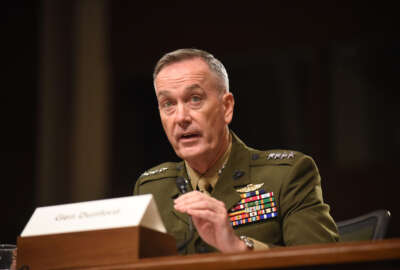The chairman of the Joint Chiefs of Staff said an expanded strategic role of his organization would not cause an increase in employees, giving the proposal a better chance of being included in the 2017 defense authorization act.
“What we are focused on is the responsibilities of the Joint Staff…We are focused specifically on the authorities of the chairman, the Joint Staff and by extension the Chiefs,” Chairman Gen. Joseph Dunford said March 29.
Lawmakers have been increasingly worried about the size of the Defense Department headquarters staff.
In a series of hearings before the Senate Armed Services Committee, multiple defense experts testified the Pentagon’s staff was bloated and wasteful.
When Defense Secretary Ash Carter and Dunford advocated for an expanded role of the Joint Chiefs during a March 17 Senate Armed Services Committee hearing, some thought twice about what that might mean for headquarters spending.
Dunford laid those concerns to rest during his speech at the Center for Strategic and International Studies in Washington. In fact, he said the Joint Staff is trying to simplify its staff.
“There are some things we are doing today that are being done in several other places and where I think the greatest opportunity for kind of delayering if you will is where services now deal with service secretaries and deal with [the Office of the Secretary of Defense] on some of those broader issues. Those are things the Joint Staff won’t do,” Dunford said.
Dunford added that the Joint Staff has taken on roles of family readiness and veterans outreach, but those roles should not be part of the organization.
“For all the right reasons of the last few years things have been picked up along the way… Some of it has been a result of the personalities of the secretaries of defense and what their expectations were from leadership. Some are a result of topical issues that leadership wanted to grip. We are trying to clean that up a little bit,” Dunford said.
The expanded role of the Joint Chiefs of Staff is rooted in DoD’s need to act on threats that move between regions and domains.
The current combatant command system separates the world into six geographic regions with their own commanders. The other combatant commands are called functional commands and consist of U.S. Strategic Command, U.S. Special Operations Command and U.S. Transportation Command. The first place where those commands integrate is at the Defense Secretary’s office.
“I would like to strengthen the role of the Joint Chiefs of Staff and the chairman,” Carter said earlier this month. “Because different [combatant commands] see different things in their regions, they are all deeply expert in their own regions, but somebody needs to put it all together and give me advice about that: how to synchronize all those forces. I look to the Chairman and the Joint Staff for that. I’d like to get to — for them to have more capability and authority to do so.”
Dunford said the Joint Staff needs to provide the defense secretary with a common operational picture and common intelligence picture. Right now the defense secretary cannot see the fight to pull together all the things each combatant command needs.
Dunford said the Joint Staff can provide a better prioritization of resources and is already moving within its current resources to provide a better picture to the defense secretary.
As far as the bloated headquarters staff goes in DoD, the department as a whole is making efforts to trim down.
DoD directed the cut in staff back in September.
“We anticipate Congress will require a 25 percent reduction in the funding of DoD headquarters in lieu of the 20 percent requirement previously established by the department,” a September memo signed by Deputy Defense Secretary Bob Work stated. “Even if Congress fails to act, the department needs the savings that will be achieved through this reduction to fund higher priority requirements in support of the warfighter and to address underfunded strategic needs.”
Current estimates of headquarters employees stand at more than 4,000 for the Joint Staff, 5,000 for the Office of the Secretary of Defense and more than 38,000 at the combatant commands, former DoD Undersecretary for Policy Michele Flournoy told Congress in December.
She added that DoD headquarters and agencies staff is now at 240,000 without contractors, which costs $133 billion a year.
Copyright
© 2024 Federal News Network. All rights reserved. This website is not intended for users located within the European Economic Area.
